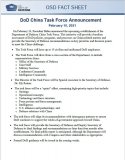For me at least it's pretty much now as it was in 2015. I acknowledge that some people may not have heard of (for example) Huawei in 2015 and only did recently because of bust-ups over 5G. That said Huawei did have more exposure than you might have thought it did in previous years because 5G proposals go way back. There was even a time when the UK was prepared to use Huawei on 5G, albeit in a limited way.
Trump's trade-tech-financial war against China alone has lifted brand awareness of many Chinese companies and the national brand of China beyond most people's wildest dream, before we even account for the solid growth internationally of many Chinese companies on their own accounts.
Huawei is obviously the best and best-known example. For all its presumed importance, 5G was a rather obscure technology known only to people inside the telecom industry. After 2 plus years of war against Huawei, so many people have come to know that Huawei is the world's leading telecom equipment company and led the competitors by at least 18-24 months technology-wise in 5G, one of most strategically important technology in the 21st century according to none other than the US government. The testimonials from the global telecom executives, including those from UK, India, Germany, etc. are proof-positive. The funny thing was that a professor with close relationship with Chinese government at the prestigious Peking University disclosed that even the Chinese government didn't know Huawei was so advanced in technology until Trump administration and foreign companies one after another warned/praised how advanced/dangerous Huawei was.
Huawei's smartphone brand & sales also got huge boost from Trump sanctions and bans. Before 2018, Huawei's smartphone was fighting with a bunch of Chinese brands for attention and market-share. It took off since 2018, the year Trump ban started, to become one of the three premium brands in smartphone or indeed electronic devices, along with Apple and Samsung. While technology and design played big parts in it, Trump ban simply boosted the brand and awareness. Many people had struggled with pronouncing Huawei, now it's become effortless. LOL.
In addition, Huawei's semiconductor design house HiSilicon, otherwise a mysterious existence inside Huawei, also become much better known to the outside world. It's got to show Huawei's technology is built on heavy investment in R&D and talents. And Huawei has consistently been among the top-five biggest corporate spenders in R&D in the world, which is a solid refute to the accusation that Huawei has been stealing technologies from others.
Huawei's same city competitor ZTE also got a boost in brand and awareness due to its own Trump ban and the reflected glow from Huawei.
Another great example is, of course, TikTok. Although TikTok was quite popular among teens in the US and around the world, it was much less known by the mainstream media and the boomer parents of the TikTok teens. Trump's war against it had changed it all, and it has become mainstream and ever more popular. People got to know that TikTok can be addictive, and has many me-to imitators among the US social media companies. Best of all, people has gotten to know that TikTok is powered by advanced AI, developed in and run from China.
If Huawei demonstrates the hardware and hard power side of China's technology, then TikTok shows the software and soft power side of Chinese tech.
And, we should not forget DJI, leading drrone-maker in a consumer tech sector almost entirely created and dominate by a Chinese private company based in Shenzhen, China's answer to the Silicon Valley. After repeated bans and restrictions, including being put on the now infamous Entity List, DJI took them all in stride and has become ever more popular.
There are much more examples, including WeChar, Alibaba, Tencent, SMIC. There are many other less known brands among general population but have gained ground within the sub-sectors of their targeted markets.
All these example get to show that China's tech sector is vast in size, technologically advanced, and comprehensive in scope. They've got the US government feeling threatened. Together, they have also changed the national brand and image of China as a technology powerhouse, versus the previous image of China as a country of assembly lines and copy-cats. They have positioned China as the rival tech superpower to the US's preeminence, thus ushering in the era of a bipolar world in the consciousness of people in the world.
And that's why China in 2021 is vastly different from that in 2015. Even its adversaries and competitors admit that. Trump administration's policies against China have played a role in accelerating the process.

